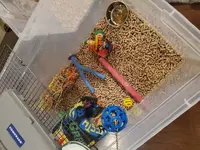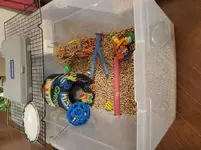You going to need Baby Bird Formula Kaytee Exact
https://www.chewy.com/kaytee-exact-...czSO6gfcPn5DQq7nDpPrR_93S9PXzPrcaAi2fEALw_wcB
Important directions to follow when mixing and keeping proper temperature to formula.
Preparation of Baby Bird Formula
Follow the manufacturer's directions when mixing the formula.
Important: "Use distilled or boiled water to eliminate bacteria growth from contaminated tap water." The water should be approximately 105-110 degrees. Add the water to the powder gradually while stirring. After thorough mixing to eliminate lumps, the formula should be the consistency of creamy pudding. This thickness will allow it to be drawn into an eye dropper or syringe or will roll off a spoon. For older birds the mixture may be made thicker.
Do not reuse mixed formula. Discard and mix fresh at each feeding.
If really necessary, sufficient amount of formula may be prepared at one time to last 3 days if covered and refrigerated after preparation. The amount needed for each feeding can be heated and fed but not reused. Caution: You might need to add water in the heating process. Diluting formula by increasing water will reduce the concentration of the diet.
Temperature to Feed Formula
The formula should be served warm- 104-106 F- but not hot, as excess heat may damage the digestive tract. It should feel Slightly warm to the touch. It is highly recommended to use a thermometer to measure the temperature.
In order to maintain the heat of the hand-feeding formula mixture, a double-boiler type arrangement can be set up with the container of prepared formula placed in a bowl or pan of warm water during the feeding process.
Feeding Area
Psittacine birds while being fed should be placed on a surface, such as a towel, where there will be insulative properties to prevent excess heat loss and a surface where they can grip with their feet, preventing slippage and possible injury.
Hand-Feeding
The most important considerations in the hand feeding process are the frequency and volume of feeding. Baby birds grow at an extraordinarily rapid rate and this growth requires a great deal of food to meet the nutritional needs of the bird. However, the crop of a young bird holds a limited amount of food, so it must be filled frequently. As the bird gets older, the capacity of the crop increases, and the number of daily feedings will be reduced. The volume to be fed is base upon a combination of observation and judgement.
Procedure
Check the Fullness of the Crop
Nature designed a rather unique feature into the digestive system of birds-a widening of the oesophagus at the lower pan of the neck This widening acts as a compartment to hold a quantity of food, and is named the crop.
The crop can be easily visualized in young birds while feathering is incomplete. In older birds with a well developed covering of feathers, the fullness can be checked by gently feeling the crop with a thumb and index finger.
The crop should be examined before each feeding. Ideally, in the rapidly growing young bird, the crop should never be allowed to become completely empty. Checking the crop fullness will help determine the frequency and volume of feeding to be given. Normally the crop will empty in 4 hours. A crop that remains full or is not emptying properly indicates some type of problem.


